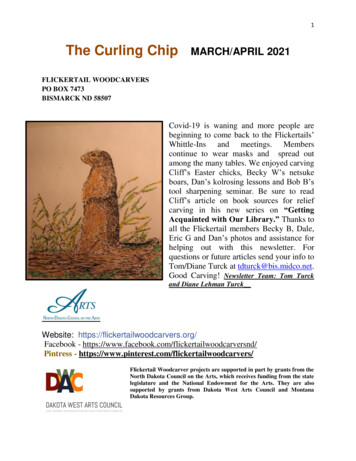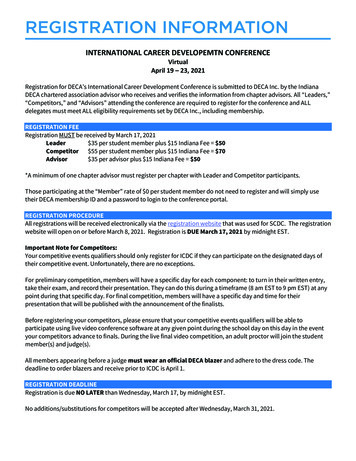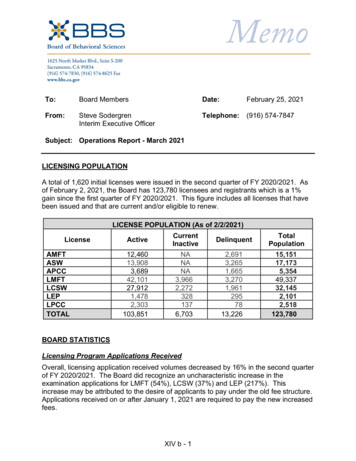
Transcription
1The Curling ChipMARCH/APRIL 2021FLICKERTAIL WOODCARVERSPO BOX 7473BISMARCK ND 58507Covid-19 is waning and more people arebeginning to come back to the Flickertails’Whittle-Ins and meetings. Memberscontinue to wear masks and spread outamong the many tables. We enjoyed carvingCliff’s Easter chicks, Becky W’s netsukeboars, Dan’s kolrosing lessons and Bob B’stool sharpening seminar. Be sure to readCliff’s article on book sources for reliefcarving in his new series on “GettingAcquainted with Our Library.” Thanks toall the Flickertail members Becky B, Dale,Eric G and Dan’s photos and assistance forhelping out with this newsletter. Forquestions or future articles send your info toTom/Diane Turck at tdturck@bis.midco.net.Good Carving! Newsletter Team: Tom Turckand Diane Lehman TurckWebsite: https://flickertailwoodcarvers.org/Facebook - Pintress - lickertail Woodcarver projects are supported in part by grants from theNorth Dakota Council on the Arts, which receives funding from the statelegislature and the National Endowment for the Arts. They are alsosupported by grants from Dakota West Arts Council and MontanaDakota Resources Group.
2Event CalendarMeetings and Whittle-Ins are held in the Fellowship Hall at Trinity Lutheran Church inBismarckSummer – June, July and August at Sertoma Park, Shelter # 5 Website: https://flickertailwoodcarvers.org/ Facebook: witter: https://twitter.com/FlickertailNDInstagram: ay 15-16, 2021Spring Carving Class Buffalo in Butternut at the ND HeritageCenterBy Bob PedigoMay 18, 2021Whittle-In, 7-9 PMProject by Alvin BraunagelJune 15, 2021Whittle-In, Sertoma Park, shelter 5, 5:30-8 PMSack lunch – Public is invitedJuly 20, 2021Whittle-In, Sertoma Park, Shelter 5, 5:30-8 PMSack Lunch – Public is invitedAugust 17, 2021Whittle-In, Sertoma Park, Shelter 5, 5:30-8 PMGrill and Potluck – Public is invited
3Past EventsSeptember 5, 2020NO MONTHLY MEETINGEnjoy your Labor Day Weekend!September 15, 2020Whittle-In, 7-9 PM TURN IN SPOONSProject by Eileen HeihnMonthly meeting 8:30-10:30 AMProject by Larry GraffOctober 3, 2020October 20, 2020Whittle-In, 7-9 PMProject by Tom & Diane TurckNovember 7, 2020Monthly meeting 8:30-10:30 AMProject by Warren SchlechtNovember 17, 2020Whittle-In, 7-9 PMProject by Doug Emerson, snow snakesDecember 5, 2020Monthly meeting 8:30-10:30 AMProject by Doug Emerson, snow snakesDecember 15, 2020Whittle-In, 7-9 PMProject by Doug SmithJanuary 2, 2021Monthly meeting 8:30-10:30 AMProject by Eric GaaslandJanuary 19, 2021Whittle-In, 7-9 PM Library Spoons ReturnEagle Feather Project by Dale HeglundFebruary 6, 2021Monthly meeting 8:30-10:30 AMProject by Bob Pedigo, love spoonFebruary 16, 2021Whittle-In, 7-9 PMProject by Troy FriezeFebruary 27, 2021Virtual Party Everyone is invitedMarch 13, 2021Monthly meeting 8:30-10:30 AM New DateProject by Cliff OrgaardMarch 16, 2021Whittle-In, 7-9 PMProject by Becky Weisgerber
4April 3, 2021Monthly meeting 8:30-10:30 AMProject by Dan BauerApril 20, 2021Whittle-In, 7-9 PMProject by Bob Pedigo, knife sharpingMay 1, 2021Monthly meeting 8:30-10:30 AM*********************************Monthly Summer Whittle-In at Sertoma ParkCome Out & Play Staying Socially DistancedLocation: Sertoma Park Shelter #5Date: June 15, July 20, and August 17Time: Around 5:30pm - 7 or 8pm: Come when you can, leave when you have togo.Chairs: There are picnic tables, but bring a lawn chair if you want.Food: As with last year, due to Covid-19, please bring your own food and utensils.You can bring hand-sanitizer, but there will be some available as well.Drink: Bring your own. It is a public park, so no alcohol, and no glass drinkingbottles. Anything else is fine.
5Projects: We always can use hearts for the Cancer Center. In general, though,bring something you want to work on. It can be carving, painting, or otheractivities like sewing, beading etc. If you’re between projects, you can always pullout one from that 1/2 finished pile that everyone has.Requirements: Bring yourself. Bring your wife, husband and/or friend. Everyoneis welcome. We will try to practice social distancing, and everyone is encouragedto bring a mask. Come to relax and have fun. Laugh, converse with friends, eat,do some carving or crafting, learn a little, even play on the nearby l Library NewsBy Cliff OrgaardAs you know, our club owns a good selection of books and videos on a variety of topics. If youare like most members, you have not taken the time to check out a book lately. Most havedetailed project instructions, useful tips, and can give the reader a broader knowledge ofcarving in general. In addition, some are just fun to read. It is my goal to highlight a topic eachnewsletter and share my thoughts on some of the gems we have in our collection.Lately, I’ve become interested in Relief Carving. I’ve never taken a class, so I watched someonline videos to pick up some basics. This method is fine for demonstrating a specific projectbut does not cover all that a person needs to know. I am happy to report that our club’s libraryhas several books on this topic. After reviewing them (and completely reading a few) I am readyto share my findings.Relief Woodcarving and Lettering (Ian Norbury) This was one of my favorite books. Eventhough it reads like a textbook sometimes, the author covers different types of reliefcarving from around the world and describes how to create a project in each of thechapters. His narrative was blunt and sometimes amusing. This book has the mostextensive set of fonts for Lettering.High-Relief Wood Carving (William J. Schnute) This is another book that I read completely.He is truly a master carver and this book would be better suited to an experienced carver.It is worth a look just to see the excellent carvings that he created.
6Relief Carving Techniques and Pictorial Relief Carving (Ivan Whillock) Both ofthese books provide detailed instructions to create three different projects.The rest of the books contain over a dozen full scale drawings for your owncarving project. Although it is not as thorough as other books, anyone lookingfor patterns can probably find one here that is worth trying.Country Flat Carving with Tom Wolfe (Text by Douglas Congdon-Martin) This book walksyou through the creation of three different projects. Each one has dozens of color picturesto demonstrate each step. This is a great book for someone that would like to carve aproject with very detailed instructions.Wildlife Carving in Relief and Relief Carving Wood Spirits (Lora S. Irish) Anyonethat has studied relief carving has heard of Lora Irish. In both books, she beginsby teaching how to set up your carving and use the tools. She then leads youthrough a detailed carving with multiple pictures. At the end of the books aremany patterns to create your own project. These books are probably better suited to someonewith prior experience with relief carving.Relief Carving Patterns – Tips – Techniques (W.F. Just) This is another book that I had toread all the way through. Mr. Just tells of his journey into the woodcarving craft and wantsto share as much of his knowledge as he can. The topics are covered in enough detail soanyone can feel comfortable starting a new project. The colored gallery of his projects isoutstanding, and he included the patterns for many of them in the back of his book.If you have a desire to try relief carving, or just to view some of the outstanding examples (withinstructions), I encourage you to check out some of these books.Happy Carving!*********************************
7Monthly Meeting Minutes for Flickertail WoodcarversMarch 13th, 2021, Trinity Lutheran ChurchEric G called the meeting to order. There were 15 people present. Ron H leftearly, and Clara came later.Thanks to Cliff Orgaard for the cute Easter chick project.Guest: None.Announcement: Our Saturday, March 6th Meeting and Whittle-In was postponeduntil the 13th, today. The church needed the Fellowship Hall on the 6th.Show and Tell: Bob P brought a several crosses, two in Black Walnut and one inbutternut for the Cancer Society.Doug E showed a lifelike winter wren in its habitat.Doug S was carving five Santas for someone to give as gifts next Christmas.Eric T is working on his set of cheetahs that are doing acrobatics on the ground.Becky W had an example of the next carving project, a small boar.Bob P also had some wood carving magazines, Wood Carving Illustrated, ChipChats and Wood Carving, that he has downsized.Secretary’s Report: A draft had been sent out. The Zoom Holiday get togetherwas mentioned. Elections were won by Becky W for property manager, Warrenfor treasurer, and Dale for program manager. Eric T motioned and Becky Wseconded.Treasurer’s Report: Eric G gave Warren’s information. There is 9,012 withaccounts up to date. Doug E motioned and Diane seconded.Membership: Doug S said about 15 people need to sign-up.Property: Becky W had no change.Library: Cliff received a Norwegian textbook on carving from Becky W.
8Publicity: Becky W had no change.Historian: Clara had no change.Facebook: Eric G is working on it.Website/Instagram: Becky B suggested that we could have virtual tables toexhibit our carvings to the public, contact her if you are interested. (repeat)Buckstop Junction: Mike was unavailable.Capital A’Fair: Becky W said it will be held on August 7 and 8. Exhibiters needto provide tables, chairs, signs etc.Wahpeton Weekend: is being held in June.Annual Woodcarver’s Show: Will be held in October this year at the CareerAcademy. The Master Carver will be Vic Hood, who will lead a class throughcarving a realistic bust of a mountain man, Indian chief or cavalry person. RickSkauge will conduct the weekend class. He has been here before and is enjoyable.The non-carver for the weekend class will be Pam Vukelic, a Certified Zentangledrawing teacher. Zentangle creates structured patterns that mimic mosaics or otherexpressions.Programs: The Spring class is Saturday and Sunday, May 15 and 16 at theHeritage Center. Originally, Rick and Cathy Brereton were going to teach carvinga loon, but travel restrictions prevent citizens from Canada and the US fromcrossing the border. In addition, Cathy has been ill with cancer and recentlyunderwent surgery. Instead of a loon from the Breretons, the class will learn tocarve a complete bison. It will be taught by Bob Pedigo from our club for 30.00.There is room for 12 participants and it will be taught from 9am-4pm each day atthe Heritage Center.Sign-ups are available now through Doug E atdd emerson@msn.com, 217 Toronto Loop, Bismarck, ND 58503, 701-425-8226.The check should be made out to Flickertail Woodcarvers.The North House Folk School is holding Wood Month this month, in March.There are videos, seminars and discussions online. See Northhouse.org
9Old Business: 1) Virtual Carving Classes. Something to think about. (repeat)And see above.2) The Zoom Party was a fun get together.3) The library wondered if we would like to arrange another display in 2022.Some ideas for a theme were suggested in common with the Spring and/or Octoberclasses. (repeat)Correction: In the article authored by Doug E in the last newsletter, I added apicture at the end and labeled it “Ron Holtz’ Memory Hearts.” I should havementioned that other people, Doug E, Larry, I and probably others donatedMemory Hearts the day of the photo.In addition 1) We now have 24 Travel mugs ( 15) and 0 Knives ( 35), numerousPatches ( 3), and Stickers ( 1) for sale. Further, we have really cool businesscards with Flickertail Facebook pictures on the back for free! (Free advertisingand they’re interesting as well).Anyone having information for the newsletter, email it to Tom Turck or DianeLehman Turck at tdturck@bis.midco.net .Having no further business, the meeting was adjourned.Respectfully Submitted by Diane Lehman Turck, Secretary*********************************March 13th, 2021 Whittle-InCliff Orgaard prepared four colorful Easter Chicks just hatching as finishedproducts to illustrate the project. He also had a sheet to pass out and information
10that the process can be viewed on You Tube under Home Wood Spirit. The start isa 1.5” x 1.5” x 2” tall block. After drawing an X on the top, you measure 3/8’from all eight side edges and another 3/8” from the bottom front. Followingdirections, you carve the shape of the egg. Next, using stop cuts, carve the top andbottom of the shells. Then cut the face in layers. Finally cut the feet and don’tforget to arch the foot. Once the egg is complete, paint it with bright colors such asyellow for the chick, white for the shell and orange-red for the beak and feet. Thechicks would add a festive touch to any Easter decoration.Bob P came with three crosses with beautiful lines of chip carving for Show andTell. Two were black walnut. Bob said he creates something from black walnutevery few years forgetting how hard and chippy black walnut is to work with. Youend up working with a knife and a bottle of glue to fix the pieces of wood comingoff that weren’t supposed to. Finished, there are two line drawn crosses in thecenter, and a stylized design at the each of the four ends. They were made for theCancer Society.Doug E carved a winter wren and added pieces of habitat to go with it. Winterwrens are little balls of bouncy energy. According to Cornell University, theyusually hold their tails straight up as they hop and scamper through the underbrushlike a mouse looking for insects. Their song is very lively and (per weight) 10times more powerful than a rooster. They are rare here as we are just west of theirmigratory route.Doug’s wren is perfectly detailed with black striped tail and wing, and white dotsat the head of the wing. The stone he is standing on it made of wood, and theaspen leaves are composed of metal. Only the twig is real.Doug S is carving a set of five old time looking Santa heads for a friend of his togive as gifts by next Christmas. He said he appreciates the length of time, ratherthan someone asking very close to Christmas so he can give the time each needsand work at a more leisurely pace. Although he notes people don’t often think ofChristmas presents at Easter time.
11Cliff’s little hatchlingsA template with lines drawn
12A close-up of the done chickBob P’s lovely crosses
13A winter wren in its environmentSanta only needs wire rimmed glasses
14Eric T is gradually perfecting his cheetahs in their dance in the air. Their balanceand gymnastic tumbling appear synchronized. Each time we see them, theybecome a little more defined. They appear so graceful and so strong. The grain ofthe wood makes them even more interesting.Becky W has the next Whittle-in and she brought in a boar called a netsuke. Theywere miniature carved button fasteners originating in Japan in the 17 th century. It’sa cute little thing with reeds or greenery growing out behind a rock sitting next tothe boar’s side.Finally, not exactly a show-and-tell, but an opportunity for everyone at themeeting. Bob P is downsizing his carving magazine collection. He spread copiesof Wood Carving Illustrated, Chip Chats, and Wood Carving on a table for anyoneto take. Any left over at the end of the evening would be deposited in recycling.Many of the issues were recent. Most of the issues found homes by the end of themeeting, but several were relegated to be reprocessed. Eric G offered to take themback to his house for the recycle trash.Gamboling cheetahs
15Start of a netsuke boarEveryone distanced and carving
16*********************************March 16th, 2021 Whittle-InBecky Weisgerber discovered a different type of carving called netsuke. In Japan,historically the basic style of dress, called a kimono, has no pockets. In the 1600s,containers known as sagemono, or crafted boxes known as inro were hung bycords from the kimono’s sash, or obi, by decorative toggles or buttons callednetsuke. Over time netsuke developed into extremely well crafted, ornately carvedminiature sculptures. Becky’s is a little round boar, sleeping adjacent to a rockwith reeds growing between the rock and up over its back. According to Becky’ssheet, netsuke were most popular during the Edo period from 1615 to 1867.According to Wikipedia, they become more artistic over time. There are a numberof forms, but most frequently seen is the sculpture netsuke, a compressed threedimensional, round shape from one to three inches in size. Netsuke are made fromboxwood or other carved woods, but most often from ivory, nowadays mammothivory, hippopotamus tusk or sometimes boar tusk. They can also be modeled fromclay, porcelain or lacquer. Some netsuke are even made from woven cane.Becky’s is made from basswood. Her sheet includes a recommended order forcarving.In addition to teaching today’s lesson, a friend of Becky’s named Robert stoppedin to learn something about carving. With Robert, there were 11 people present.Becky had tools and a beginner’s lesson set up for him to do.Mike came with several interesting topics of discussion. One, he was wonderingwhere the knife we voted to put in our Buckstop collections was, so that he couldtake it there. I said that I didn’t know, but perhaps Eric G or Doug E would. Heand Eric G were visiting later, so hopefully the whereabouts of the knife werefound.Second, he had a Chip Chats magazine from July/August 1980. The lead articlewas about a man named Peter Wolf Toth who was born in Hungary andimmigrated to the US. He made it his mission to carve a large Native AmericanIndian in every state. He has accomplished that and more. In addition there is onein Ontario and Manitoba as well as a statue of Stephen I in Hungary. The carving
17in North Dakota was completed in 1981, was created out of cottonwood, is 25 feetin height and is in Mandan at the Stage Stop at 601 6th Avenue SE.The rock side and front view of the little netsukeThe other side view of the netsuke
18Working together, but well separatedPeter Toth and an example of his Native American carvings
19Mike’s most recent carving, Joseph PeaveyThird Mike brought in his most recent project a figure of Joseph Peavey completewith the peavey tool he invented in 1857 as an improvement on a logging toolcalled a cant hook to free log jams floating down river. Besides the peavey, he wasan inventor who came up with a number of other ideas that are still in use.Not much work has been done on Eric T’s cheetahs since three days ago. They dostill delight the eye, however.Eileen has a couple of pleasing carvings. The first are two Cancer Hearts. One is amedium blue with a braided cord attached and the slightly larger one is turquoisewith a dark rose cord tied on top.The second is a Dala rooster. Eileen doesn’t know how to paint in the rosemålingstyle of Scandinavia. It’s a decorative folk art painting normally done on woodand often done on Dala carvings. Eileen wanted to paint her rooster, though, soshe gave it an Easter look. She used flat basic colors. Red for his comb andwaddle, brown for his beak and eye, then four striped colors on his body - yellow,
20purple, pink and blue - separated by scalloped lines. The base of the bird isturquoise and the tail is green with grass green lines representing feathers.Cheetahs learning from each otherTwo hearts for the Cancer Society
21A Dala roosterdressed for Easter*********************************Monthly Meeting Minutes for Flickertail WoodcarversApril 3rd, 2021, Trinity Lutheran ChurchEric G, Becky B and Dale were unavailable so Diane called the meeting to order.Bob P acted as secretary. There were 10 people present. Becky B left early.Thanks to Dan Bauer for the fun, informative kolrosing lesson.Guest: None.Show and Tell: Bob P brought a napkin holder carved with a cornucopia on eitherside. Very well done.Larry displayed a kolrosing spoon he used for the library exhibit.Eric T is working on a cute little Scottie dog.
22Cliff O had an example of relief carving from a library book.Finally, there is another spoon, but its ownership is unknown.Secretary’s Report: Diane reported that a draft from last month had been sent out.Treasurer’s Report: Warren gave information that there is 9,012 with accountsup to date.Membership: Doug S was unavailable.Property: Becky W was unavailable.Library: Cliff noted that there has been some activity lately. Becky B borrowed abook before today’s meeting.Publicity: Becky W was unavailable.Historian: Clara was unavailable.Facebook: Eric G was unavailable.Website/Instagram: Becky B suggested that we could have virtual tables toexhibit our carvings to the public, contact her if you are interested. (repeat)Buckstop Junction: Mike was unavailable.Capital A’Fair: Becky W said it will be held on August 7 and 8. Exhibiters needto provide tables, chairs, signs etc. (repeat)Wahpeton Weekend: is being held in June (repeat).Annual Woodcarver’s Show: Will be held on October 9-10 of this year at theCareer Academy. The Master Carver will be Vic Hood, who will lead a classthrough carving a realistic bust of a mountain man, Indian chief or cavalry person.Rick Skauge will conduct the weekend class. He has been here before and isenjoyable. The non-carver for the weekend class will be Pam Vukelic, a CertifiedZentangle drawing teacher. Zentangle creates structured patterns that mimicmosaics or other expressions. (repeat)
23Programs: The Spring class is Saturday and Sunday, May 15 and 16, from 9am4pm each day at the Heritage Center for 30. It will be complete bison taught byBob Pedigo from our club. There is room for 12 participants and there are severalspaces left. Sign-ups are available through Doug E at dd emerson@msn.com, 217Toronto Loop, Bismarck, ND 58503, 701-425-8226. The check should be madeout to Flickertail Woodcarvers.Old Business: 1) Virtual Carving Classes. Something to think about. (repeat)2) The library wondered if we would like to arrange another display in 2022.Some ideas for a theme were suggested in common with the Spring and/or Octoberclasses.In addition 1) We now have 24 Travel mugs ( 15) and 0 Knives ( 35), numerousPatches ( 3), and Stickers ( 1) for sale. Further, we have really cool businesscards with Flickertail Facebook pictures on the back for free! (Free advertisingand they’re interesting as well).Anyone having information for the newsletter, email it to Tom Turck or DianeLehman Turck at tdturck@bis.midco.net .Having no further business, the meeting was adjourned.Respectfully Submitted by Bob Pedigo, Acting Secretary*********************************April 3rd, 2021 Whittle-InDan Bauer came prepared with everything we needed to try our hands at kolrosing.Because it’s a technique rather than a project, he had tongue depressors for us touse for practicing. He had a hand-out to explain the steps you need to go throughby Harley Refsal, an expert in Scandinavian flat plane wood carving.The first step is to sand the surface with fine to extra fine sandpaper, or 400 grit allthe way to 1000 grit paper. Then lightly sketch the design you want to etch withpencil. The third step is the one that a couple of us missed. Cover the drawing
24completely with paraffin before making any incisions and fourth, try not to go backover an incision making a second line.Next, use a circular motion to rub in mix of the oil and color. Then rub on oil suchas flaxseed for food-safe items or Danish oil. Don’t use an oil that might becomerancid. Wipe off oil with a paper towel. If you missed making a line somewhere,add it now, rub in color and oil on the new lines and, again, wipe off access.Completing step four of the process
25Tongue depressor designsSeventh, re-sand the entire surface with 1000 grit sandpaper to close or lock incolor.
26The other pages of Dan’s directions showed spoons and spreaders with patterns onthem and a sheet with different kinds of motifs or drawings that could be created.Dan cautioned that curved lines are a bit trickier than straight lines.Almost everyone began plan and execute their sketches. You can’t get toocomplex with a tongue depressor, of course, but everyone tried somethingdifferent. Since they were all just simple illustrations, I didn’t mark down who didwhich picture.During the meeting Show and Tell, Bob P revealed his expertly carved napkinholder. It’s a deeply incised cornucopia of fall produce surrounded by leaves donein butternut. Both sides have been decorated.In keeping with today’s lesson, Larry brought a lovely love spoon. It was one ofthe items recently on exhibit. The bowl has a delicate kolrosing design of leavesand dashed lines outlined by two tracks around the bowl. The handle contains twocutout hearts also framed by kolrosing and a little decoration at the end.An expression of bounty
27Larry’s love spoon with kolrosing decorationEric T’s Scottie ready to play
28Cliff promoting use of the libraryAn enigmatic spoon. Whose is it and does it have meaning?
29Eric T is working on a charming little Scottie dog. He’s quite a difference from thecheetahs that have been coming lately.Cliff showed a page out of a relief carving book from the library. Please look athis article on several of the books on relief carving we have that might be ofinterest to you. Most contain detailed patterns with colorful pictures. Some are formore experienced carvers, but all give good tips on how to initiate a project.Lastly, someone had a spoon with a decorated handle. It is divided in halflengthwise by an outline. The top picture is red geometric shapes, three rectangles,a triangle and two other figures. It looks like the sun. The bottom characters looklike raindrops although they are probably something different. The direction ofboth halves appears to be directed towards the bowl of the spoon.*********************************April 20th, 2021 Whittle-InBob Pedigo is teaching a class on tool sharpening. It is helpful that he does this forthe club periodically to refresh our knowledge base. There are three types of toolsused in wood carving, the knife, the gouge, and the V-tool. In carving a project, hesays your knife should be sharpened about once an hour during use, and if youwant assurance that the blade is like a razor, you can shave a few of the hairs onyour thumb or a small patch on your arm to check for sharpness.Most of the time, all you need for sharpening is a leather strop. Apply somestropping compound, usually a powder, to the leather. When you pull the blade ofthe knife (from back to front) over the leather, try to make the number of times oneach side equal. In addition, keep turning it towards the back side of the bladerather than the side you’re trying to sharpen so you don’t accidently hit the blade.The back of the knife blade should be only about 1/32” off the surface. Bob allowsfor only one bevel on his sharpened knives. A flatter bevel is necessary for acarving knife; a pocket knife uses a steeper bevel for cutting rope or cardboard.
30The bottom drawing shows a bevel on all but the back of the knifeIn sharpening a gouge, hold it perpendicular to the sharpening surface, and roll itfrom one side to the other. Use a rotating motion in sharpening the gauge. The sizeof the bevel should correspond to the size of the curve of the gouge.For normal execution, the sides of a V-tool should be straight and meet at thebottom. When creating a relief carving, the wings can follow the base of the toolto make carving easier. Indeed, Bob tries to keep the edges slightly behind thebottom V. Making the sides parallel and coming together at the tool’s base isdifficult. For instance, in working on a V-tool of Cliff’s, he could not get the twosides exactly parallel. He would push the tool into a soft piece of wood to see if itwas perfect yet. V-tools seem the most difficult to get back to their correct form ifthey get out of shape.One implement that is beneficial to have is some type of lighted magnifier. It notonly enlarges the tool you are viewing, but lighting it gives a further resolution towhat you are trying to see. This can be effective with all tools, but especially a Vtool.
31A lighted magnifier and V-toolOne of Bob’s tool sharpeners
32One of the devices Bob has is an EZE Lap Diamond Hone Stone with acarborundum stone for sharpening or honing on the front, and a leather strip heglued on the back as a strop.The club has a power sharpener. It’s a little faster than Bob likes, but it gets thejob done. Bob has his own sharpener. This one is comprised of a coarser stone, afiner stone and a leather strop between them. At the right side is a buffer wheel.The coarse stone removes material rapidly so a dull edge can be made sharperquickly. The finer stone refines the edge. The wheel does get hot and spritzing itwith water is necessary so the stones don’t overheat which can damage the tool’sedge. When sharpening, either with or without power maintain the angle on bothsides, than through all the grits you use. Remember, too, that the lower the angleyou hone your knife at, the sharper it will be. And, according to WoodcarvingIllustrated, a shallow angle means the knife will glide through basswood and pine.On the other hand it will need sharpening more often.Bob working on the sharpener with Cliff’s V-tool
33Bob buffering Eileen’s gougeBesides talking us through how to sharpen our tools, as I mentioned, Bob borroweda V-tool that needed some extra work from Cliff and later a gouge from Eileen. Heattempted to get the V-tool perfectly set up, but the wings were being difficult toget just right. Then he worked on a gouge of Eileen’s which had some problemswith its curve. A number of the people in the audience stood near Bob to watchhow he worked on the different wheel
Wildlife Carving in Relief and Relief Carving Wood Spirits (Lora S. Irish) Anyone that has studied relief carving has heard of Lora Irish. In both books, she begins by teaching how to set up your carving and use the tools. She then leads you through a detailed carving with multip










